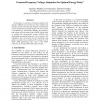Free Online Productivity Tools
i2Speak
i2Symbol
i2OCR
iTex2Img
iWeb2Print
iWeb2Shot
i2Type
iPdf2Split
iPdf2Merge
i2Bopomofo
i2Arabic
i2Style
i2Image
i2PDF
iLatex2Rtf
Sci2ools
80
Voted
ICCD
2004
IEEE
2004
IEEE
Frontend Frequency-Voltage Adaptation for Optimal Energy-Delay^2
In this paper we present a clustered, multiple-clock domain (CMCD) microarchitecture that combines the benefits of both clustering and Globally Asynchronous Locally Synchronous (GALS) designs. We also present a mechanism for dynamically adapting the frequency and voltage of the frontend of the CMCD with the goal to optimize the energy-delay2 product (ED2P). Our mechanism has minimal hardware cost, is entirely selfadjustable, does not depend on any thresholds, and achieves results close to optimal. We evaluate it on 16 SPEC 2000 applications and report 17.5% ED2P reduction on average (80% of the upper bound).
| Added | 16 Mar 2010 |
| Updated | 16 Mar 2010 |
| Type | Conference |
| Year | 2004 |
| Where | ICCD |
| Authors | Grigorios Magklis, José González, Antonio González |
Comments (0)

